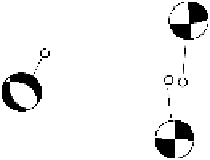Geoscience Reference
In-Depth Information
different the internal structure of the Archaean Earth may have been. Of course,
there is an analogous structure in the modern Earth: the liquid outer core.
Finally, in this discussion of the diversity of continents and their history, it
should be noted that the other planets have different tectonics. Even Venus, which
is so similar to the Earth, seems to have evolved in quite a different way. However,
that subject is planetology, and each planet deserves a topic for itself, matching
geophysics with aphroditophysics, aresophysics and even plutophysics, puzzles
for the next generation of geophysicists.
Problems
1. Calculate the elastic thickness of the subducting Indian plate beneath (a) the Lesser
Himalayas and (b) the Greater Himalayas.
2. Fault-plane solutions similar to those shown in Fig. 10.67 were obtained for earth-
quakes on the North Anatolian Fault in Turkey. Can you give a simple explanation for
them?
3. Calculate how long it would take for three-quarters of a given mass of oil to convert
to gas at the following temperatures: (a) 160
◦
C, (b) 180
◦
C and (c) 220
◦
C.
4. If oil that had apparently been heated to 160
◦
Cwere found, what would you infer
about the tectonic setting of the host sediments?
5. How much gas would you expect to find associated with an oil deposit that had been
heated to a maximum temperature of 150
◦
C?
6. (a) Calculate the thickness of sediment with density 2.1
Figure 10.67.
Earthquake
focal mechanisms on the
North Anatolian Fault in
Turkey. (After Jackson and
McKenzie (1984).)
×
10
3
kg m
−
3
that would be
deposited in a subaqueous depression 0.5 km deep.
(b) What would happen if a Precambrian ironstone sediment with density 4
×
10
3
kg m
−
3
were deposited in the basin?
7. Assume that the asthenosphere behaves as a viscoelastic material. What is its viscous-
relaxation time? (Use 70 GPa for Young's modulus.) Does this value seem reasonable
to you?
8. An elastic plate 1000 km long, with a flexural rigidity of 10
25
Nm,isfixedateach
end.
(a) Calculate the critical value of the horizontal compressive force for this plate.
(b) Calculate the critical stress associated with the compressive force (stress
=
force
per unit area).
(c) Comment on the magnitude of your answers. What do they indicate about the
behaviour of the lithospheric plates?
9. Calculate the critical value of the compressive stress for a 0.5-km-thick rock layer
that is isostatically supported by the underlying lithosphere. What is the wavelength
of the initial deformation?
10. Calculate the effective elastic thicknesses for the three model lithospheres shown in
Fig. 10.35(a). Which one would you intuitively expect to be appropriate for the North
American plate?

